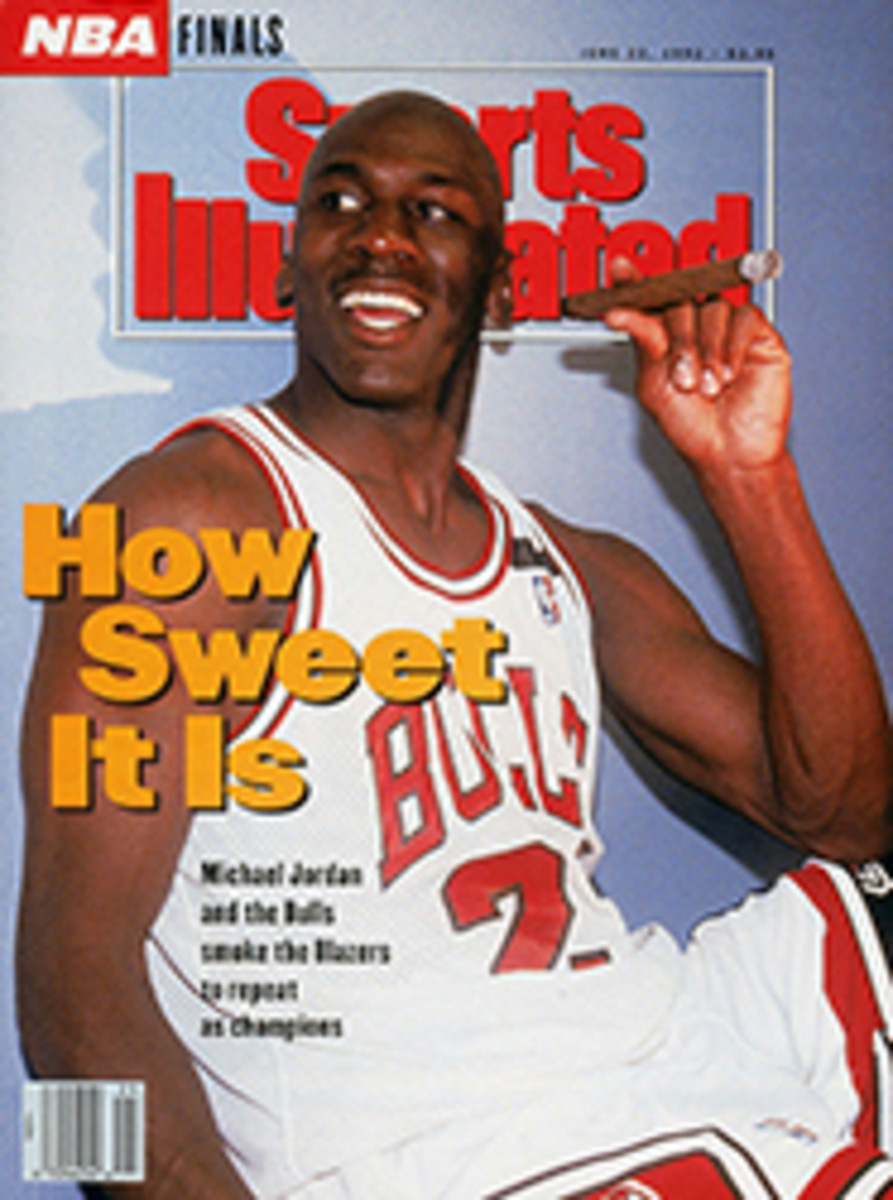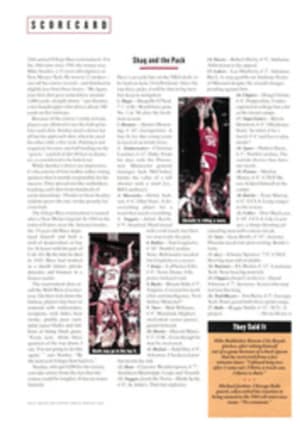
SCORECARD
A True Test?
It has been almost four years since Canadian sprinter Ben Johnson tested positive for anabolic steroids at the Seoul Olympics. How far has drug testing in track and field come since then? As the Barcelona Olympics approach, two potential medalists—Katrin Krabbe of Germany, the women's world champion at 100 and 200 meters, and Butch Reynolds of the U.S., the world-record holder in the 400—are challenging drug-related suspensions on grounds that the testing procedures were flawed.
Krabbe was suspended by the German track and field federation on Feb. 15. Although her urine sample was drug free, tests showed that her sample and those from two other sprinters had come from the same person. Upon appeal, the federation said there was no conclusive evidence that the three samples had been manipulated, and ruled that the runners could compete in Germany. The International Amateur Athletics Federation (IAAF) has yet to decide whether they can compete internationally.
The IAAF suspended Reynolds after he tested positive for a steroid in August 1990. Reynolds appealed, claiming that his results had been confused with another athlete's, but on May 11 an IAAF appeals panel upheld his suspension. Then on May 28 a U.S. district court judge in Columbus, Ohio, granted him a temporary restraining order, allowing him to compete until June 18 (SI, June 8). Reynolds has since qualified for the U.S. Olympic Track and Field Trials beginning on Friday in New Orleans.
TAC, the governing body of track and field in the U.S., finds itself in a quandary. Reynolds was planning to seek another restraining order this Thursday that would allow him to run in the trials. The IAAF has threatened to ban any athlete who competes against Reynolds, and two weeks ago the organization's president, Primo Nebiolo, said, "We will never accept a decision of any court in the world against our rules." If Reynolds gets the restraining order and shows up at the trials, what will TAC do? And if he competes, what will the IAAF do?
Such questions of jurisdiction have rarely been asked in track and field. The testing programs of TAC and the IAAF involve such complicated procedures that samples are inevitably mishandled, allowing athletes to appeal and regain the right to compete. Athletes rarely sue, but their threats to do so are sometimes enough to get TAC or the IAAF to back down. In this case TAC was willing to allow Reynolds to compete, but, for once, the IAAF stuck to its guns.
Over the last few years track and field has tried to put more teeth into its drug policies. Last August the IAAF increased the suspension for using banned substances from two to four years. And TAC now conducts out-of-competition testing. But these and other revisions have done nothing to eliminate the flaws that obviously still exist in the testing procedure itself. Moreover, there is still no test for several performance-enhancing drugs, and a new mail-order product can apparently mask almost any banned substance.
So, despite the progress it has made, track and field is now perceived as a drug-ridden sport. If the sport hopes to eradicate that perception, it must find a way to make testing procedures more reliable. Bad drug testing is worse than none at all.
—MERRELL NODEN
Pray Ball
Allen Hye, a German professor at Wright State in Dayton, has come up with his all-religious baseball team: C, Steve Christmas; 1B, Luke Easter; 2B, Johnny Temple; SS, Jose Pagan; 3B, Tim Teufel (Teufel means "devil" in German); OF, Jesus Alou, Angel Bravo and Bob Christian; P, Preacher Roe; reliever, Jim Gott (Gott means "god" in German); manager, Harry Lord.
Dogleg Down
The first hole of the Elfego Baca golf tournament is a long one—2½ miles—but at least it's downhill. The tee is atop Socorro Peak, 7,280 feet above sea level. The green is at 4,730 feet, near the campus of the New Mexico Institute of Mining and Technology in Socorro, about 65 miles south of Albuquerque. The first hole is so demanding (players take as long as five hours to rappel from tee to green) that it's the only one on the course.
At 7:00 a.m. last Saturday, 10 golfers were hauled to the top of Socorro Peak in four-wheel-drive vehicles to begin the 24th annual Elfego Baca tournament. For the 10th time since 1981 the winner was Mike Stanley, a 31-year-old engineer at New Mexico Tech. He won in 12 strokes—one off his course record—and finished in slightly less than three hours. "We figure your first shot goes somewhere around 1,000 yards, straight down," says Stanley, a two handicapper who drives about 300 yards on flat fairways.
Because of the course's rocky terrain, players are allowed to tee the ball up before each shot. Stanley used a driver for all but his approach shot, when he used his other club, a five-iron. Putting is not required, because any ball landing on the "green," a patch of dirt 60 feet in diameter, is considered to be holed out.
While Stanley's drives are impressive, it's his coterie of four walkie-talkie-toting spotters that is mainly responsible for his success. They spread out like outfielders, tracking each shot from hundreds of yards downslope. Thanks to them Stanley seldom incurs the one-stroke penalty for a lost ball.
The Elfego Baca tournament is named after a New Mexico legend. In 1884 in the town of Frisco, near the Arizona border, the 19-year-old Baca deputized himself and held a mob of desperadoes at bay for 36 hours with his pair of Colt .45s. By the time he died in 1945, Baca had worked as a sheriff, lawyer, private detective and bouncer in a Juarez casino.
The tournament does recall the Wild West of yesteryear. On their trek down the fairway, players may have to contend with rattlesnakes, scorpions, rock slides, heat stroke, prickly pear cacti, spiny yucca blades and millions of biting black gnats. "Every year, about three quarters of the way down, I say, 'I'm not going to do this again,' " says Stanley. "By the next year I forget how bad it is."
Stanley, who got $200 for his victory, can take solace from the fact that the course could be tougher: It has no water hazards.
Shaq and the Pack
Here's an early line on the NBA draft, to be held on June 24 in Portland. After the top three picks, it will be thin in big men but deep in swingmen:
1. Magic—Shaquille O'Neal, 7'1", LSU. Would have gone No. 1 in '90 after his freshman season.
2. Hornets—Alonzo Mourning, 6'10", Georgetown. A fine fit for this young team in need of an inside force.
3. Timberwolves—Christian Laettner, 6'11", Duke. From his days with the Pistons, new Minnesota general manager Jack McCloskey knows the value of a tall shooter with a snarl (i.e., Bill Laimbeer).
4. Mavericks—Jimmy Jackson, 6'6", Ohio State. A do-everything player for a team that needs everything.
5. Nuggets—Adam Keefe, 6'9", Stanford. Hard-nosed with a soft touch, but Denver may trade the pick.
6. Bullets—Tom Gugliotta, 6'10", North Carolina State. Rebounder needed, but Gugliotta is a scorer.
7. Kings—LaPhonso Ellis, 6'8", Notre Dame. Fills power forward void.
8. Bucks—Bryant Stith, 6'5", Virginia. Coveted for work ethic and intelligence. Next Sidney Moncrief?
9. 76ers—Walt Williams, 6'8", Maryland. Hyphenated talent: scorer-passer, guard-forward.
10. Hawks—Harold Miner, 6'5", USC. Even though he may be overrated.
11. Rockets—Todd Day, 6'8", Arkansas. Checkered past but worth the risk.
12. Heat—Clarence Weatherspoon, 6'7", Southern Mississippi. Leaps and 'bounds.
13. Nuggets (from the Nets)—Malik Sealy, 6'8", St. John's. Thin but explosive.
14. Pacers—Robert Horry, 6'9", Alabama. Athleticism is the appeal.
15. Lakers—Lee Mayberry, 6'2", Arkansas. But L.A. may gamble on Anthony Peeler of Missouri despite the assault charges pending against him.
16. Clippers—Doug Christie, 6'6", Pepperdine. Underexposed in college but a hit at the tryout camps.
17. SuperSonics—Byron Houston, 6'6", Oklahoma State. So what if he's barely 6'6" and has to play inside?
18. Spurs—Hubert Davis, 6'5", North Carolina. The outside shooter San Antonio needs.
19. Pistons—Marlon Maxey, 6'8", UTEP. He, too, helped himself at the camps.
20. Knicks—Tracy Murray, 6'8", UCLA. Long-ranger to the rescue.
21. Celtics—Don MacLean, 6'10", UCLA. Like Laettner, a sharp-shooting talented big man with a mean streak.
22. Suns—Sean Rooks, 6'10", Arizona. Phoenix needs low-post scoring, Rooks's forte.
23. Jazz—Elmore Spencer, 7'0", UNLV. Best big man still available.
24. Warriors—P.J. Brown, 6'11", Louisiana Tech. Next-best big man left.
25. Clippers (from Cavaliers)—David Johnson, 6'7", Syracuse. Scorer who may not last this long.
26. Trail Blazers—Jon Barry, 6'5", Georgia Tech. Point guard with three-point range.
27. Bulls—Reggie Smith, 6'11", TCU. A project.
—HANK HERSCH
PHOTO
GEORGE TIEDEMANN (REYNOLDS)
Reynolds still hopes to run at the trials.
PHOTO
DOUGLAS MERRIAM (ELFEGO BACA)
The first hole at the Elfego Baca gives new meaning to "elevated tee."
PHOTO
MARTHA JANE STANTON (KEEFE)
Keefe may go in the top 5.
PHOTO
MARTIN A. FOLB (CHRISTIE)
Christie is riding a wave.
They Said It
Mike Boddicker, Kansas City Royals pitcher, after taking himself out of a game because of a back spasm that he recovered from a few minutes later: "I played long toss after I came out. I threw a trash can. I threw a chair."
Michael Jordan, Chicago Bulls guard, when asked his reaction to being named to the NBA all-interview
team: "No comment."

